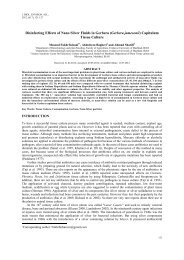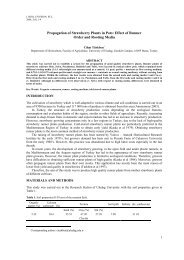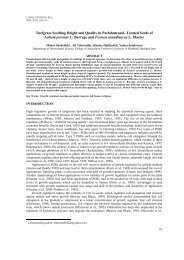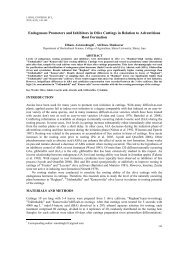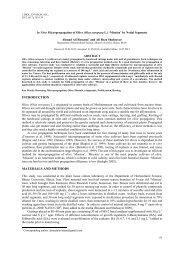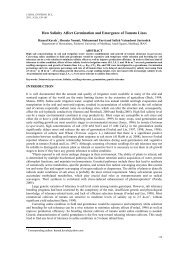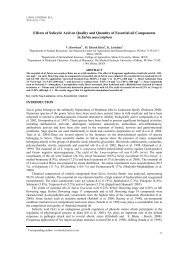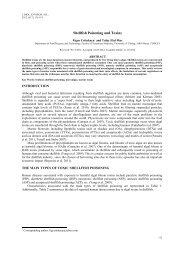Taxonomic Investigations on the Epiphytic Lichens on Quercus sp ...
Taxonomic Investigations on the Epiphytic Lichens on Quercus sp ...
Taxonomic Investigations on the Epiphytic Lichens on Quercus sp ...
You also want an ePaper? Increase the reach of your titles
YUMPU automatically turns print PDFs into web optimized ePapers that Google loves.
J. BIOL. ENVIRON. SCI.,<br />
2009, 3(7), 17-24<br />
MATERIALS AND METHODS<br />
Study area<br />
Bursa is located at latitude 39–40° N, l<strong>on</strong>gitude 28–29° E in <strong>the</strong> north-west of Turkey, south-west of <strong>the</strong><br />
Marmara Regi<strong>on</strong>. Bursa is affected by a A Mediterranean climate (Akman 1999). The mean annual rainfall is<br />
731,1 mm, and <strong>the</strong> mean maximum temperature is 30,9 °C in August, while <strong>the</strong> mean minimum temperature<br />
is 1,7 °C in January (DGIGM 1974). Uludag mountain, which is <strong>the</strong> study area, is located at latitude 40° N<br />
and l<strong>on</strong>gitude 29° E in <strong>the</strong> south of Bursa. It is <strong>the</strong> highest mountain in Western Anatolia, with its peak at<br />
Uludag Tepe (2543m). Sarıalan Yaylası, Kirazlıyayla, Kadıyayla, Sobra Yaylası which high plateaus are <strong>on</strong><br />
<strong>the</strong> nor<strong>the</strong>rn side of <strong>the</strong> Uludag. There are some glacial lakes <strong>on</strong> <strong>the</strong> high summits of <strong>the</strong> mountain such as<br />
Aynalıgöl, Buzlugöl, Karagöl, Kilimligöl (Kaynak et al. 2005).Uludag is affected by a Mediterranean climate<br />
type and frozen in winter. Uludag’s climate changes from lower to higher altitudes (Akman 1999).<br />
Uludag have 5 vegetati<strong>on</strong> z<strong>on</strong>es; Lauretum (up to 350 m), Castanetum (up to 350–700 m), Fagetum<br />
(750–1500 m), Abietum (1500–2100 m), Alpinetum (up to 2100 m) (Özhatay and Çırpıcı 1987).<br />
Mediterranean vegetati<strong>on</strong> such as maquis and frigana is present up to 350 m <strong>on</strong> Uludag (Çetin 1999).<br />
Collecting samples and identificati<strong>on</strong><br />
85 lichen taxa bel<strong>on</strong>ging to 34 genera and 15 families were determined from 772 lichen samples collected<br />
from 30 stati<strong>on</strong>s between 06.06.2004 and 24.05.2006(Table 1).<br />
The lichen samples were examined with a stereomicroscope (Olympus SZ 40) and a high power<br />
microscope (Olympus CH–2) for external morphology and anatomical observati<strong>on</strong>s. The lichen samples were<br />
identified with <strong>the</strong> and of several flora books and identificati<strong>on</strong> keys (Clauzade and Roux 1985, Jahns 1987,<br />
Purvis et al. 1994, Wirth 1995, Brodo et al. 2001, Giralt 2001, Blanco et al. 2004, Nash III et al. I-II, 2004).<br />
Specimens are deposited in <strong>the</strong> Herbarium of <strong>the</strong> Biology Department (BULU) of <strong>the</strong> Faculty of Art and<br />
Sciences Uludag University in Bursa. Authors names are abbreviated according to Brummitt and Powell<br />
(1992).<br />
The <strong>Quercus</strong> <strong>sp</strong>p. were identified with several flora books and identificati<strong>on</strong> keys (Davis et al. 1982,<br />
Yaltırık 1984, Mataracı 2004).<br />
RESULTS<br />
In this study, 772 lichen samples were determined <strong>on</strong> <strong>Quercus</strong> <strong>sp</strong>p. (Table 2). 85 lichen taxa bel<strong>on</strong>g to 34<br />
genera are reported <strong>on</strong> <strong>Quercus</strong> <strong>sp</strong>p. of <strong>the</strong>se <strong>sp</strong>ecimens, 61 taxa were found <strong>on</strong> Q. cerris var. cerris, 59 <strong>on</strong> Q.<br />
petraea s<strong>sp</strong>. iberica, 56 <strong>on</strong> Q. petraea s<strong>sp</strong>. petraea, 32 <strong>on</strong> Q. pubescens, 21 <strong>on</strong> Q. frainetto, 21 <strong>on</strong> Q.<br />
infectoria s<strong>sp</strong>. infectoria and 19 <strong>on</strong> Q. robur s<strong>sp</strong>. robur (Table 3). According to <strong>the</strong> literatures, 7 taxa are<br />
recorded first time from Bursa. These <strong>sp</strong>ecies are Candelariella reflexa (Nyl.) Lettau, Lecanora allophana<br />
(Ach.) Rühl., L. expallens Ach., L. glabrata (Ach.) Malme, Clad<strong>on</strong>ia digitata (L.) Hoffm., Lecanora<br />
intumescens (Rebent.) Rabenh. and Usnea chaetophora Stirt.<br />
It was observed that seven lichen <strong>sp</strong>ecies grow <strong>on</strong> all examined <strong>Quercus</strong> <strong>sp</strong>p. (Table 2). According to<br />
<strong>the</strong> literature, <strong>the</strong>se <strong>sp</strong>ecies are cosmopolite. In our study, ıt was identified that <strong>the</strong>se <strong>sp</strong>ecies have no<br />
selectivity for substrate and have high tolerance for Evernia prunastri (L.) Ach., Lecanora carpinea (L.)<br />
Vain., L. subcarpinea Szatala, Lecidella elaeochroma (Ach.) M. Choisy, Melanelixia fuliginosa s<strong>sp</strong>.<br />
glabratula (Lamy) Coppins, Pleurosticta acetabulum (Neck.) Elix & Lumbsch and Pseudevernia furfuracea<br />
var. furfuracea (L.) Zopf.<br />
18



